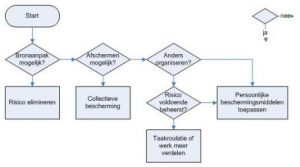When PPE must be used
An important principle of occupational hygiene is that hazards or risks are combated at the source as far as possible. The purpose of this occupational hygiene strategy is to effectively manage safety and health risks. If risks do not arise, protection against them with PPE becomes unnecessary, and a burden is removed from employees. The occupational hygiene strategy is as follows:

Combat at source:
- Eliminate the risk: do not repeat the process, do not use the same substance
- Replace hazard source: safer machine, less harmful substance.
- Change working method: robotisation, remove substances with local extraction.
- Change the workplace: ventilate area if it concerns a substance, erect scaffolding if it concerns working at height
Shield:
- Shield the source itself: place it in a box, put up a barrier
- Compartmentalisation: place in separate enclosed space
Organise:
- Expose employees for less time: rotate jobs, distribute the work among more employees
Personal protection:
- Use personal protective equipment
When determining collective protection measures, business economics may be taken into account to a certain extent. Personal protective equipment is sometimes selected over collective equipment, because the cost of the latter is disproportionately high compared to individual protection. However, economics may not play a role when it comes to possible exposure to carcinogens. In that case, standard procedure is to look for a less harmful replacement, if possible.
Types of protective equipment
Uniper has a wide range of personal protective equipment and work clothing. There are very diverse workplaces within the various units with associated specific risks, so the right equipment tends to vary across the company. There are detailed instructions in nearly all units about the various rules in each production area. These are often clearly indicated by icons on installations and in the production areas.
PPE categories
All PPE must have a CE mark. Depending on its nature, a subdivision can be made on the nature of each risk against which the PPE must provide protection.
Category 1
Low risks; this could be protective equipment used for relatively low risks, such as gardening or working in rainy or humid weather. There is no specific risk demanding the use of a particular type of PPE. Such PPE is exempt from EC type approval.
Category 3
Complex design for high-risk situations; protective equipment manufactured in series which is subject to EC type approval: Applicable in the case of complex protection equipment which protects the user from life-threatening hazards, or situations that can seriously and permanently damage health, and where the designer assumes that the user cannot be aware of the acute effects in good time. A manual must be supplied with such protective equipment that instructs the user about its use and maintenance. .
Protective equipment that does not fall in Category 1 or Category 3 is automatically classed as Category 2 protective equipment.
Questions, advice, and remarks about PPE
For questions, advice and remarks about PPE, please contact your safety officer. He or she can assess the extent to which wearing PPE is the best solution for every situation, and if so, which PPE.